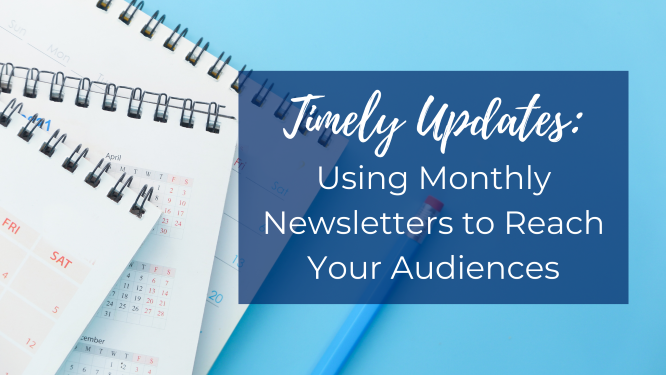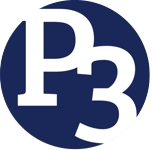
23 Jun Timely Updates: Using Monthly Newsletters to Reach Your Audiences
Trying to keep your community informed about updates and information throughout a project? Newsletters are a great communication tool for doing so! Newsletters are articles focused on specific project information and updates that are physically mailed or emailed to stakeholders and residents within a community. Newsletters work best with a subscribed group of interested individuals that sign up to receive regular updates.
If you have a good amount of interested community members that are subscribed or want to subscribe for updates, a newsletter is a great communication tool to keep them informed and involved about a project. Newsletters can include pertinent information about a project including an overview of the project, upcoming events and participation opportunities, contact information for project staff, and more. As newsletters are generally sent to subscribers on a regular schedule, newsletters can also include month-to-month or quarterly project updates to keep your audience up-to-date on the project and any decisions being made.
Here are some tips for writing newsletters that effectively reach, inform, and involve your subscribed audience:
Determine the frequency and format of your newsletter.
When first planning a strategy for newsletter communications, it’s important to ask yourself these two questions:
- How frequently do you want to send your newsletter out to subscribers?
- Do your subscribers prefer printed versions or digital versions of materials?
Answers to these two questions will help you in the planning and distribution process. Determine the frequency that you wish to send out a newsletter (we recommend monthly but depending on the project it could be more or less frequently!) and create a schedule for dates to be sent out.
Also determine from subscribers what the best format for the newsletter is. While a digital newsletter might be easier, you have to consider whether a printed or mailed version might reach your participants better. The cost of not reaching participants may be far greater than the cost of mailing a newsletter.
Create a template for your newsletter.
As newsletters will be sent out regularly (although the frequency depends on your agency and the project!), it’s best practice to create a template that can be used for each publication. Determine the section headings and what information you want to convey with each newsletter. While the information in the sections will most likely change each time it’s sent out, the sections should remain somewhat similar. This will create uniformity and allow ease of reading and understanding for subscribers.
Some recommended newsletter sections could be:
- Announcements
- Project Updates
- Contact Information
- Upcoming Participation Opportunities
- And more!
Ensure that your newsletters are not too information-heavy.
While newsletters are a great way to convey updates and information about a project to subscribers, they should not be filled to the brim with information either. Keep information concise to encourage more people to subscribe to and read the newsletter. Use graphics to help demonstrate concepts and ideas, or pictures to make the page(s) less text-heavy. If more information is needed or available about a particular topic, encourage readers to check out a project website or external resources within the newsletter!
Instead of using newsletters as a primary form of communication of information and updates, use them to supplement other communication methods and provide consistent updates to those that are interested in receiving them.
Regularly remind the public about the newsletter and call for new subscribers.
Depending on the type of newsletter you are sending out, it’s beneficial to remind the public about opportunities to subscribe. While paper newsletters may be mailed to residents in a project’s area, digital newsletters are generally only sent to those that subscribe for project updates – so be sure to continually remind community members to subscribe if you are using digital!
At public meetings, after online surveys, and on the project website, include an option for interested community members to add in their email address or additional information to subscribe for project updates. Verbally remind those that attend in person as well! It’s also a good idea to bring a few copies of printed newsletters to public events with you to hand out to interested attendees. This will ensure that the newsletter reaches even more people in a community and is thus more effective.
Additionally, with mailed newsletters it can also be beneficial to ask if there are any residents or additional interested parties that are interested in receiving the newsletter and are not receiving it currently. You may want to include a section in the newsletter to ask readers to share with interested community members. Perhaps some residents missed it in the mail and they never received it. It doesn’t hurt to check in and ensure that as many people are being reached as possible!
Don’t rely solely on newsletters to communicate updates.
Newsletters are great for communicating information and updates about a project, but they should not be your only form of communication. Remember, it is always best practice to utilize multiple communication methods when reaching out to community members. This ensures that the most people are informed and are able to get involved as possible.
Further, while newsletters are a great communication tool to use during a project, if you’re only using a digital version, they only send information to subscribers that sign up to receive it. Thus, you may not be reaching a large amount of a community’s population if you rely solely on digital newsletter communications. While mailed newsletters do not share the same subscriber limitation, it’s always best practice to use a variety of communication tools to reach your community.
If you are looking for a convenient way to regularly communicate project updates and information with subscribers, newsletters are a great tool to use! However, ensure that you are also utilizing additional methods of communication to effectively reach an inclusive representation of your community!
What communication method should we #Explain next? Connect with us on social media and let us know!
Want to be notified when we release a new blog post? Subscribe to our P3 newsletter. And don’t forget to follow us on Facebook and LinkedIn!
About the Author: Katie Maynard started her journey with Public Participation Partners as a Community Engagement Assistant in January 2020 and became a Communications and Engagement Specialist in June 2021. When not assisting with public involvement, Katie enjoys reading, traveling to the beach, and spending time with her pets.


Sorry, the comment form is closed at this time.